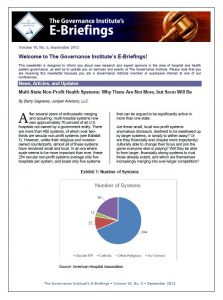Multi-State Non-Profit Health Systems: Why There Are Not More, but Soon Will Be
 After several years of enthusiastic merging and acquiring, multi-hospital systems now own approximately 70 percent of all U.S. hospitals not owned by a government entity. There are more than 400 systems, of which over two-thirds are secular non-profit systems. However, unlike their religious and investor-owned counterparts, almost all of these systems have remained small and local. In an era where scale seems to be more important than ever, these 284 secular non-profit systems average only five hospitals per system, and boast only five systems that can be argued to be significantly active in more than one state.
After several years of enthusiastic merging and acquiring, multi-hospital systems now own approximately 70 percent of all U.S. hospitals not owned by a government entity. There are more than 400 systems, of which over two-thirds are secular non-profit systems. However, unlike their religious and investor-owned counterparts, almost all of these systems have remained small and local. In an era where scale seems to be more important than ever, these 284 secular non-profit systems average only five hospitals per system, and boast only five systems that can be argued to be significantly active in more than one state.
Are these small, local non-profit systems anomalous dinosaurs, destined to be swallowed up by larger systems, or simply to wither away? Or are they financially and (maybe more importantly) culturally able to change their focus and join the game everyone else is playing? Will they be able to form larger, financially strong systems to rival those already extant, and which are themselves increasingly merging into ever-larger competitors?
The hospital industry is uniquely structured among U.S. industries, particularly in its complete lack of dominant players. HCA, the largest system, has less than a 4 percent market share by number of hospitals. Typically, large industries have three or so dominant players and several niche ones; the hospital industry has nothing but niche players.